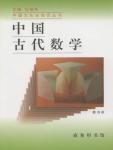Chapter 1 Chapter 1 Summary of Ancient Chinese Mathematics
During the long journey from barbarism to civilization, our ancestors gradually became aware of the concepts of number and shape.Most of the unearthed Neolithic pottery is round or other regular shapes. There are various geometric patterns on the pottery, and there are usually three landing sites, all of which are the germination of geometric knowledge.There are records in the ancient books of the pre-Qin period of "making numbers at the head of the official", "knotting events with ropes", and "carving logs to record events", which shows that people gradually understood numbers from distinguishing the quantity of things and created symbols for counting.There are already 13 counting characters in the oracle bone inscriptions of the Yin and Shang Dynasties (14th-11th century BC), the largest number is "thirty thousand", and the smallest is "one".One, ten, one hundred, one thousand, ten thousand each have their proper names.It already contains the germination of the decimal position value system.It is said that Fuxi created the "rules" for drawing circles and the "moments" for drawing squares, and it is also said that Huangdi's courtier, 倕 [chuichui], was the founder of "rules" and "standards".As early as when Dayu was controlling the water, Yu used the "left guideline" (holding the guideline in his left hand) and "right rule" (holding the guideline in his right hand) ("Historical Records · Yu Benji").Therefore, we can say that "gauge", "moment", "quasi", and "rope" are the earliest mathematical tools used by our ancestors.People measure the area of land, measure the height of mountains and valleys, calculate the yield, exchange corn, and formulate calendars, all of which require mathematical knowledge. "Zhoubi [bi Maid] Suanjing" contains Shang Gao's answer to the Duke of Zhou's question, mentioning the use of moments to measure the profound and far-reaching.According to legend, in the early years of the Western Zhou Dynasty (11th century BC), the Duke of Zhou (the 11th century BC) made rituals, and mathematics became one of the six compulsory courses in the education of noble children - one of the six arts.However, at that time, I was studying in the government, and the development of mathematics was quite slow.
During the Spring and Autumn Period, with the appearance of iron tools and the improvement of productivity, China began the transition from slavery to feudalism.New production relations have promoted the development and progress of science and technology.At this time, the royal power was declining, the domains were scattered, and private schools began to appear.At the latest at the end of the Spring and Autumn Period, people had mastered the complete decimal position value notation method, and widely used the advanced calculation tool of counting chips.People are already familiar with the nine-nine multiplication table, the four arithmetic operations on integers, and use fractions.

